Most of the larvae of moths are herbivorous, so they inevitably compete with humans for natural resources, especially harming crops, causing huge economic losses to humans.
1. Grape tiger moth (Hua Lihu)
Seudyra subflava Moore

Mature larvae are 32-42 mm in diameter; the front end of the body is thin, the rear end is thick, and the 8th abdominal segment is slightly raised; the head is orange with black spots formed by black hairs, and the hairs are light brown; the front chest shield is orange with black spots on it. The hairy process, buttock plate is orange-yellow, and the brown spots on the hairy process are light brown connected to form a wide horizontal line; the dorsal line is light yellow and obvious, and other lines are not obvious; the setae are light yellow, the valve is elliptical, the valve screen is gray-yellow, and the circumference is The spiracles are black; the outside of the thorax is brown, the ventral foot is yellow, and there are irregular dark brown spots on the outside of the base.
There is one generation a year. The pupae spin silk in dead leaves and shallow soil to decorate the leaves or stick to soil particles to make indoor poking. The pupae survive the winter. They emerge in early or mid-July of the following year and lay eggs on the underside of the host leaves. Newly hatched larvae are black with gray-white bristles. It mainly damages grapes and ivy.
Distribution: Heilongjiang, Liaoning, Hebei, Shandong, Guangdong, Jiangxi, Hubei, Guizhou; Japan, North Korea.
2. Hawkmoth (horned childhood)
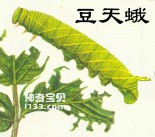
Larvae of the family Sphingidae are large, stout, cylindrical, and smooth, with a tail-like protrusion on the eighth abdominal segment, called a tail horn. This is unique to the families Sphingidae and Sphidae. Most of the body color is green, but there are also other colors, and some have diagonal stripes or eye-shaped spots on the sides. When resting, the front part of the body is often raised high, the head is retracted, and the patient remains motionless for a long time. Agricultural pests include bean hornworm, sweet potato hornworm, eggplant hornworm, peach hornworm, etc.
3. Insects can also chew metal (Two-tailed boat moth)
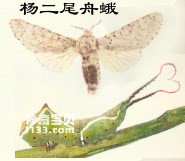
Mature larvae are 48-53 mm long; their heads are reddish-brown, with black spots on their cheeks. They are often retracted under the prothoracic shield when stationary; they are yellow-green, with green dorsal line, pink sub-dorsal line, and white lower edge. The prothoracic shield is large and Hard, yellow-green, with a round black spot on both sides of the front edge, the back of the metathorax protrudes into a peak, and there are white horizontal spots on the side of the fourth abdominal segment, extending from the subdorsal line to the base of the ventral foot, and the hip foot extends to 1 The long tail horn has reddish-brown micro-thorns on the horn. The tail horn can turn out a red flesh band when it is touched, and can be retracted when it is quiet. The sieve of the valve is black, the perivalve piece is brownish-yellow, the lower part of the valve is darker, the abdomen is pink-green, the thorax is yellowish-brown; the ventral foot is green, and the part is yellowish-brown.
The second generation (Liaoning, Shandong, Hebei, Ningxia) to the third generation (Shaanxi, Henan) occur every year. Mature larvae often bite wood chips at the base of tree trunks, bark seams, branch bifurcations and houses, spin silk and stick to form cocoons to pupate and survive the winter. The cocoons are hard and gray-brown like bark. They are often caused by larvae chewing wood to form cocoons. , causing branches to break easily due to wind, and sometimes due to the close contact between cables and branches, mature larvae bite the cable lead and form cocoons, causing circuit accidents. Overwintering pupae emerge in late April and lay eggs on the host leaves. Eggs are laid loosely, oval, reddish brown. Newly hatched larvae are black. The larvae mainly damage various poplars and willows, and have also been collected on apple trees.
Distribution: Northeast, Inner Mongolia, Ningxia, Gansu, Shaanxi, Hebei, Shandong, Henan, Hubei, Sichuan, Jiangsu, Zhejiang, Jiangxi, Fujian, Taiwan, Tibet; Japan, North Korea, Russia.
4. Juvenile Mimicry (Morris-winged Geometrid)
Zamacra excavata Dyar

The larvae are accustomed to perching on branches. When slightly disturbed, the larvae hide their heads ventrally, making their bodies semi-circular. At this time, the dorsal spines and ventral spines protrude, much like the surrounding leaves. Mature larvae are 30-35 mm long; body color is yellow-green; head is brown, and the sides are slightly lighter in color; front and sides of the chest are yellow, and there are ocher-yellow spines on the back of segments 1-4 of the abdomen, and prominent spines on segments 2-4. Relatively long, there is a pair of brown-green spines on the back of the 8th abdominal segment, the intersegmental membrane of each body segment is yellow, the subdorsal line of the 4th to 8th abdominal segment is pink-green, the ventral line is dark green, the valve is yellow, the perispiral plate is black, and the abdomen There is one light green spine on each side of each segment from 2 to 5; the thoracic legs are light green with dark brown ends; the ventral legs are green with brown ends.
Two generations occur in a year, and the second generation larvae cause serious damage in mid-to-late July. After the larvae mature, they go into the soil to pupate and survive the winter. The larvae mainly damage mulberry, poplar, etc.
Distribution: Beijing, Hebei; Japan, North Korea.
5. The killer of green plants (armyworm)
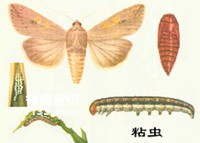
Armyworm is a general in the pest camp and belongs to the family Lepidoptera. Armyworm moths, like migratory locusts, can migrate in groups over long distances. They fly very fast, flying 40-80 kilometers per hour, and can fly continuously for seven or eight hours without stopping, flying at an altitude of about 200 kilometers. rice. If a swarm of moths stops in a certain area to lay eggs, there will be a large armyworm infestation in that area. Because armyworm moths fly at night and hide during the day, they are difficult to detect. Therefore, it is quite alarming to find the damage caused by larvae, so people call them explosive pests. The larvae eat up a crop and then move to other places in groups. They move quickly and in unison, just like an army marching, so people also call it "march bugs." All parts of our country are seriously harmed by this insect.
In 1970, there was a large armyworm outbreak in Yunnan Province. In some places, one person could catch two or three larvae in a morning. The number of larvae can reach more than 200,000 per acre, and more than 2.7 million tons of larvae were caught in Yiliang County alone. People looked at the field ridge and saw a large area of darkness, and the sound of crackling was terrifying. With the change of cultivation system, the occurrence of armyworm has increased significantly and the occurrence area has continued to expand. From 1970 to 1978, there were six major outbreaks across the country. In 1977, the area in which armyworms occurred nationwide reached 180 million acres.
Over the years, relevant scientific research units have worked closely together. Through marking and recovery, moth catching at the sea surface, and analysis and research on the occurrence patterns of armyworms in various places, we have basically confirmed the harmful patterns of armyworm overwintering and long-distance seasonal north-south migration. , providing scientific basis for further improving forecasting and prevention.
6. Caterpillar (Red-bellied White Light Moth)
Spilarctia subcarnea (Walker)

The body length of mature larvae is 46-55 mm. The head is small and black. The body is yellowish brown and densely covered with long brown hairs. There are 4 horizontal black spots on the back of the mid-thorax and the first abdominal segment of the abdomen, and there is a pair of black hairy tumors on the back of the 7th-9th abdominal segments. The thorax and ventral legs are black.
There are 2-6 generations in a year. The mature larvae spin silk in fallen leaves or shallow soil to make cocoons and overwinter. The first-generation adults in the north emerge in May, and the second-generation adults emerge in July-August. Adults live under host leaves during the day and mate and lay eggs at night. The eggs in the egg masses are arranged in rows, and each mass contains dozens to hundreds of eggs. The newly hatched larvae live in groups on the underside of leaves and eat the mesophyll, leaving the epidermis. The older larvae eat the leaves, leaving only the main veins and petioles. The larvae crawl very fast and have the habit of feigning death when they fall to the ground and curling their bodies into a ring when exposed to vibrations.
Omnivorous, the main species include soybeans, cotton, corn, sweet potatoes; potatoes, castor beans, mulberries, melons, green manure, cruciferous vegetables and other plants.
Distribution: North China, East China, Hubei, Sichuan, Yunnan; Japan, North Korea, Philippines.
7. Face-changing (Persimmon Big-headed Worm)
Percnia giraffata Guenee
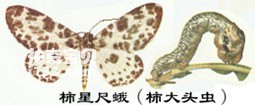
The body length of mature larvae is 49-55 mm; the head is brown and black, and the single eye area is black; the prothorax is small and starts to expand from the middle thorax, and the first section of the hindthorax and abdomen are particularly enlarged (also known as the big-headed larvae), which is yellowish brown and has black spots on the back. Vertical strips, with a pair of eye spots on each side, much like a snake's head, seeming to have changed its face to the junction of the chest and abdomen. The dorsal line of the abdomen to the upper line of the valve is grey-green, the valve line is gray-white, the ventral surface is dark brown, each body segment has irregular black lines, the valve is black, the peri-spiral plate is gray-black, the thorax and feet are black, and the ventral feet are brown and green. The newly hatched larvae are all dark, shiny, and tinged with mucus.
There are two generations in a year, and the pupae spend the winter in rock crevices and moist layers of dead leaf debris. Adults begin to emerge in late May and lay eggs on the backs of leaves or on young shoots. They are often arranged in blocks, with more than 40 to 70 eggs in each block. Each female can lay about 600 eggs. The larvae begin to hatch in mid-June, and around the 28th day of the larval stage, the larvae often spin silk and droop, hanging in the air and swinging in the wind to transfer damage to other leaves.
The larvae damage persimmons, dates, wood, walnuts, etc., but when severe, they also feed on the leaves of various fruit trees, forest trees, oil plants, crops, etc.
Distribution: Hebei; Henan, Yexi, Sichuan, Anhui, Taiwan; Japan, North Korea.
8. Silent summons (larvae live in groups)
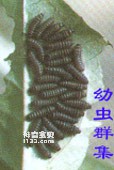
The larvae of many lepidopteran insects have the habit of living in groups, especially in the early stages. They often line up head to head in a neat line to feed. Some species disperse and feed after the third instar, while others gather in groups to cause damage throughout the entire larval stage. Many species of the family Nest Moth can spin silk to build nests and swarm inside the nests.
9. Thorns planted on the skin (thorn moth larvae)
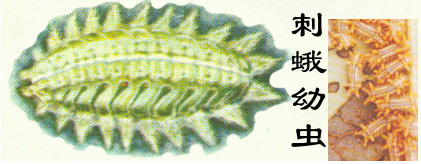
The larvae of the family Erythrididae are oval, or slug-shaped, with thorns and poisonous hairs on their bodies. When touching the skin, they will immediately become red, swollen, and extremely painful. They are commonly known as "itchy spicy", "hot spicy" or "hot spicy". "Stingy caterpillar", hence the name thorny moth. Most species of larvae damage the leaves of commercial crops, trees and fruit trees.
10. Canopy Boating (Scaphomoth Larvae)
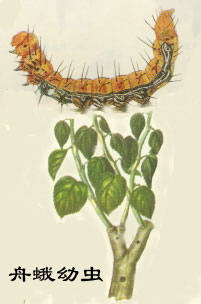
The larvae of the family Scaphothidae are mostly brightly colored with stripes and often have unique body shapes. When the larvae are still, they are often fixed by their abdominal legs and their heads.The tail is raised and swings continuously when frightened, like a rippling dragon boat. It has long been called scaphoid, which is also the origin of the name of this subject. The larvae eat leaves and are mostly broad-leaved tree pests. They often occur in forests, shelterbelts, street trees and nurseries. Some species harm fruit trees and bamboos, and a few species harm gramineous crops.
We created this article in conjunction with AI technology, then made sure it was fact-checked and edited by a Animals Top editor.